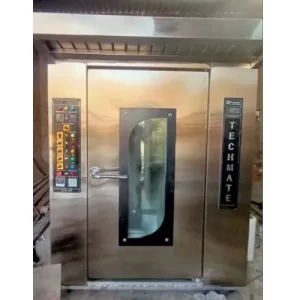Bakery Machinery
-
₹387,072.00
Single Trolley Cake Making Bakery Oven
₹387,072.00 -
-
Bakery Machinery – The Ultimate Guide to Features, Types, Benefits, and Buying Tips
Introduction to Bakery Machinery
The bakery industry has seen significant growth over the years, with increasing demand for bread, cakes, cookies, pastries, and other baked goods. To keep up with this demand, bakery businesses, commercial kitchens, and food processing units rely on high-quality bakery machinery to enhance productivity, maintain consistency, and reduce manual labor.
Modern bakery machines are designed to automate baking processes, improve efficiency, and ensure hygiene standards. Whether you are running a small bakery, a large commercial production unit, or an industrial-scale bakery, investing in the right bakery equipment is crucial to success.
This comprehensive guide covers everything about bakery machinery, including types, features, working mechanisms, advantages, price ranges, installation tips, and maintenance guidelines to help you make an informed decision.
Types of Bakery Machinery
Bakery machinery is categorized based on the stages of baking – from dough preparation to baking, cooling, and packaging. Below are the essential machines used in a bakery:
1. Dough Preparation Machines
These machines help in mixing, kneading, and shaping the dough for various baked goods.
✅ Bakery Mixer (Dough Mixer / Planetary Mixer / Spiral Mixer)
-
Used for mixing flour, water, yeast, and other ingredients.
-
Spiral mixers are best for bread and pizza dough, while planetary mixers are used for cakes and pastries.
-
Available in capacities from 5L to 100L+ for small to industrial bakeries.
✅ Dough Sheeter Machine
-
Flattens and rolls dough into uniform thickness.
-
Used for making pastries, croissants, and pizza bases.
✅ Dough Divider & Rounder Machine
-
Divides large dough batches into equal portions.
-
Ensures uniform bread rolls, buns, and pav.
✅ Dough Proofer (Fermentation Machine)
-
Creates the ideal temperature and humidity for dough rising.
-
Essential for bread, buns, and pizza dough.
2. Baking & Cooking Equipment
These machines handle the actual baking process.
✅ Bakery Oven (Deck Oven / Rotary Oven / Convection Oven)
-
Deck ovens are best for bread and pizza.
-
Rotary ovens are used in large-scale commercial bakeries.
-
Convection ovens distribute heat evenly for cakes and pastries.
✅ Tunnel Oven
-
Used for mass production of bread, biscuits, and cookies.
-
Ensures consistent baking quality.
✅ Pizza Oven
-
Specially designed for pizzerias and bakeries offering pizzas.
✅ Cake Baking Oven
-
Designed for baking sponge cakes, pastries, and cupcakes.
3. Post-Baking Processing Machines
Once baking is complete, the final products need cooling, slicing, and packaging.
✅ Bread Slicer Machine
-
Cuts bread into evenly sized slices.
-
Ideal for commercial bread production.
✅ Cooling Conveyor / Cooling Rack
-
Allows baked goods to cool properly before packaging.
✅ Packaging Machine
-
Seals and packs bread, biscuits, and pastries in air-tight wrapping.
-
Ensures longer shelf life and hygiene.
✅ Cake Decorating & Icing Machine
-
Automates cake frosting and decoration.
Key Features of Bakery Machinery
When selecting commercial bakery equipment, consider the following features to enhance efficiency and quality:
1. High-Capacity Production
-
Machines are available in different capacities based on bakery size.
-
Industrial models handle bulk production for mass sales.
2. Digital Controls & Programmable Settings
-
Modern machines feature touchscreen controls, timers, and pre-set programs for precision.
3. Stainless Steel Construction
-
Ensures durability, corrosion resistance, and hygiene.
4. Safety Features
-
Emergency stop buttons, overheating protection, and auto shut-off enhance operator safety.
5. Energy Efficiency
-
Energy-saving bakery equipment reduces electricity costs and enhances sustainability.
6. Easy Cleaning & Maintenance
-
Machines with removable trays, bowls, and self-cleaning functions ensure easy upkeep.
How Does Bakery Machinery Work?
Step 1: Dough Preparation
-
Ingredients are measured, mixed, and kneaded using a dough mixer.
-
The dough is then divided, shaped, and proofed.
Step 2: Baking Process
-
The prepared dough is placed in a deck oven, convection oven, or rotary oven for baking.
-
The oven ensures even heat distribution for perfect baking.
Step 3: Cooling & Processing
-
Once baked, products are placed on cooling conveyors to reach room temperature.
-
Cakes are decorated and frosted using automated machines.
-
Bread is sliced, wrapped, and packed for distribution.
Benefits of Using Bakery Machinery
✅ Increases Productivity
-
Automates the baking process, allowing high-volume production.
✅ Maintains Consistency & Quality
-
Ensures uniform mixing, kneading, baking, and slicing for a professional finish.
✅ Saves Time & Labor Costs
-
Reduces manual effort, leading to faster production cycles.
✅ Enhances Hygiene & Safety
-
Stainless steel machinery prevents contamination.
-
Temperature-controlled ovens ensure safe baking.
✅ Customizable & Versatile
-
Different machines cater to various baking needs (bread, cakes, pizza, cookies, etc.).
How to Choose the Right Bakery Machinery? (Buying Guide)
✅ Consider Production Capacity
-
Choose machinery based on daily production needs.
✅ Energy Consumption & Efficiency
-
Look for low-energy consumption models.
✅ Safety & Durability
-
Ensure the machine meets safety and hygiene standards.
✅ Budget & Warranty
-
Always check for after-sales service and warranty options.
Conclusion
Investing in the right bakery machinery can enhance productivity, reduce costs, and maintain consistency in baked goods. Whether you run a small bakery or a large commercial production unit, selecting high-quality, efficient bakery equipment is key to success.
🚀 Looking for the best bakery machinery? Explore top-rated models and boost your bakery business today! 🚀




